U.S. may deny asylum for females fleeing gender-based violence
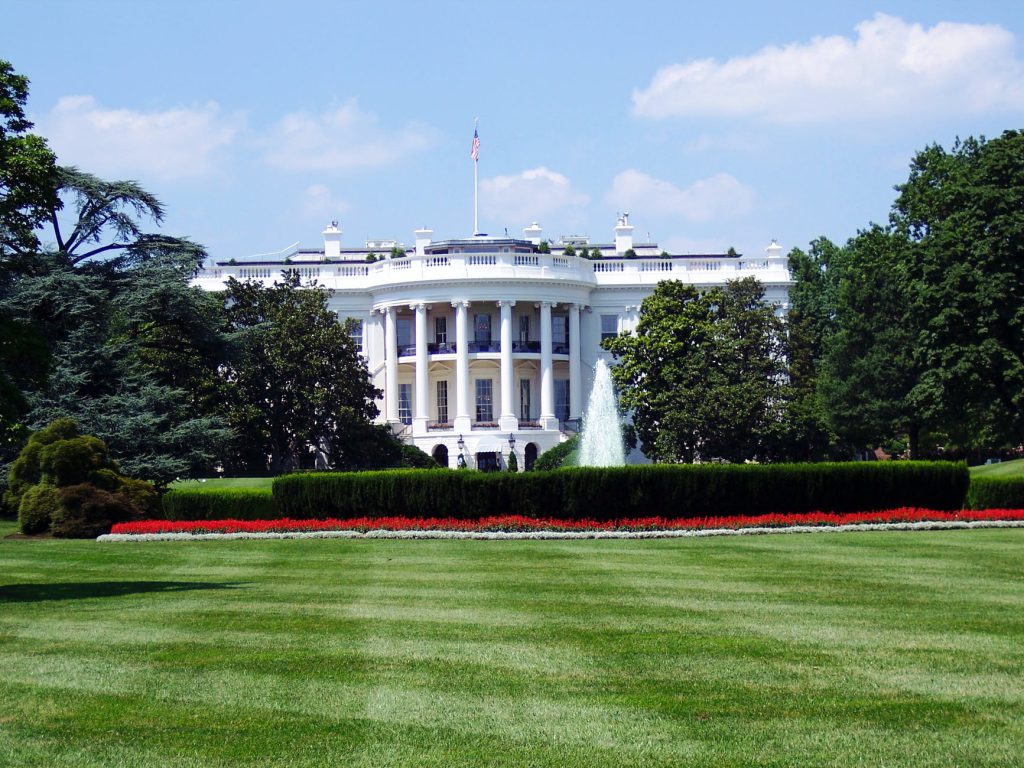
By Hunter Kessous (Follow this link to take action immediately and stand with survivors before July 15th.) At the age of 17, Fauziya Kassindja narrowly escaped undergoing female genital cutting (FGC) and a forced marriage in her home country of Togo. She used a fake passport to make her way to the United States, and upon arriving at the border, explained to the officials that her document was fake and she was there to seek asylum. She was placed in a maximum security prison for nearly two years. Her case for refuge was initially denied, and was appealed to the highest immigration court in the U.S. where she was finally granted asylum. In 1996, Fauziya became the first to gain refuge in the U.S. on the grounds of escaping FGC. Her victory set the precedent for future immigrants to receive asylum from gender-based persecution. In addition to the precedent set by Kassindja’s case, there are multiple legal reasons why FGC qualifies as persecution. It violates multiple human rights documents, including the Universal Declaration of Human Rights, the International Covenant on Civil and Political Rights, and the Convention on the Rights of the Child among others. To qualify for refugee status, an individual must prove the persecution they fear is for reason of her race, religion, nationality, membership of a particular social group, or political opinion. FGC is often thought to be a religious requirement. It can also be argued that opposition to FGC is a political opinion. It seems obvious that FGC should be grounds for asylum in the U.S. Yet, women are still refused for reasons that are often untrue or impossible, such as “woman can refuse to be cut” or “the woman can relocate.” or “the woman can relocate.” Now, refuge for women escaping FGC may be significantly limited. A proposed rule by the Homeland Security Department and Executive Office for Immigration Review set to be finalized on July 15th, would radically restrict eligibility for asylum, especially for those fleeing gender-based violence (GBV) and for LBGTQIA+ individuals. The regulation bars evidence that supports an asylum claim if it could be seen as promoting cultural stereotypes. On this basis, a judge could refuse refugee status to a woman fleeing FGC because the judge may think it promotes a cultural stereotype. A woman escaping GBV could be denied asylum on the grounds that feminism is not a political opinion. It even allows officials to dismiss some asylum applications without a hearing. These are only a few examples of the many ways this rule would dismantle the U.S. asylum system. We must act now to protect women and girls. The rule will go into effect July 15th, but before it is finalized the government must read and respond to comments sent by organizations and individuals. To submit a comment, follow this link. A sample comment is provided, but it is imperative to make your comment unique in order to ensure that it is read and responded to accordingly. For more resources to fight the finalization of this harmful rule, read this document containing websites for action-taking, informative webinars and articles, and sign-on letters.
Population Council hosts second webinar on FGM/C research
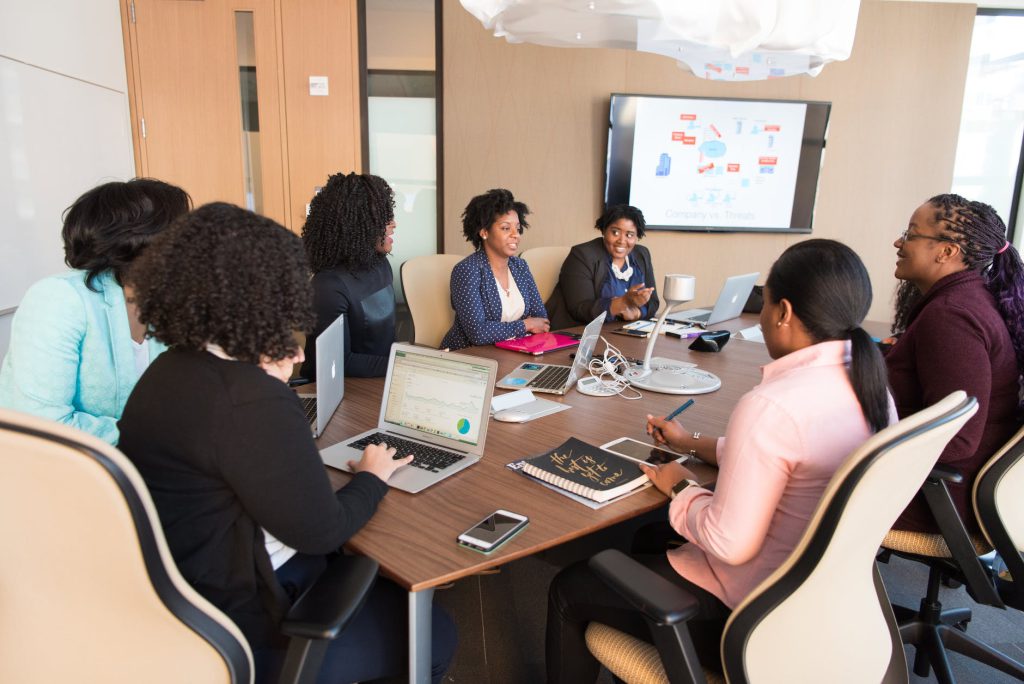
By Hunter Kessous The Population Council recently hosted a fascinating webinar, “Using Research to Understand and Accelerate The Abandonment of Female Genital Mutilation/Cutting (FGM/C).” It was the second of two webinars from a series titled, “Evidence to End FGM/C: Research to Help Girls and Women Thrive.” The most recent webinar reported some of the findings of a research consortium that began in 2015 and culminated this year. The research spanned eight countries, studying FGM/C, and researched how initiatives to end the practice may be optimized. Speakers included Bettina Shell-Duncan, University of Washington Seattle (Moderator); Nada Wahba, Population Council, Egypt; Dennis Matanda, Population Council, Kenya; P. Stanley Yoder, Medical Anthropologist; and Nafissatou J. Diop, UNFPA. Dr. Matanda spoke on the use of data to inform programming. His research spanned Kenya, Nigeria, and Senegal, and sought to map hotspots for FGM/C. The data pinpointed the areas of each country in which FGM/C is most prevalent. Dr. Matanda’s findings also reveal how factors relating to a girl’s mother influence the likelihood that she will be cut. The results varied by region, but some of these factors included the mother’s ethnic group, her beliefs surrounding FGM/C, and if she herself was cut. The most important takeaway from Dr. Matanda’s research is that considering only national data masks local variations. He recommends linking regional data to subnational policies and efforts to prevent FGM/C from occuring to future generations of girls. Medical anthropologist Dr. Yoder responded to Dr. Matanda’s research, remarking that Kenya was the only country of the three where the level of education of the mother was found to have an effect on the risk of a girl being cut. He proposes modernization, the shift from traditional and rural to secular and urban, as an explanation for Dr. Matanda’s findings. I believe that Dr. Yoder’s theory illuminates a need for ongoing research on this subject that correlates the changes in Kenya’s social, economic, and political growth to changes in the continuation of FGM/C. Following Dr. Yoder’s analysis, Nada Wahba presented her research on the intersection of FGM/C and gender in Egypt. Hers was a qualitative study with multiple intriguing findings. One discovery that I found especially important was that conflicted mothers have been turning to doctors to decide on their behalf whether or not their daughter should be cut. This could be a result of increasing medicalization of FGM/C in Egypt. Another interesting finding was that if either one of the parents, whether it be the mother or the father, does not want their daughter to be cut, then she will not undergo FGM/C. While many programs working to end FGM/C target the mother as the decision maker, Wahba’s research clearly shows that mothers are not the only influential group. For this reason, more anti-FGM/C programs should shift their efforts to also educate fathers and doctors, particularly in regions with high rates of medicalization. Nafissatou Diop followed Wahba’s presentation to provide analysis of the research. Diop feels strongly that FGM/C is rooted in gender inequalities, yet not nearly enough programs acknowledge this fact. She claims many programs that address cutting are gender blind, focusing too much on the consequences of FGM/C in their approach rather than the root causes for why FGM/C continues in the first place. Diop’s comments were a strong call to action for all advocates to take a gender transformative approach in order to achieve abandonment of FGM/C. More information about this research project can be found here. The webinar can be viewed here.
Population Council hosts webinar highlighting research on FGM/C

By Hunter Kessous On May 14th, the Population Council hosted the first of two webinars comprising a series titled, “Evidence to End FGM/C: Research to Help Girls and Women Thrive.” Beginning in 2015 and culminating this year, the Population Council has led a research consortium spanning eight countries that studied the practice of female genital mutilation/cutting (FGM/C) and how initiatives to end the practice may be optimized. The first webinar, “Improving the Health and Legal System’s Response to FGM/C,” allowed researchers to present the findings of certain studies. Speakers included Bettina Shell-Duncan, University of Washington; Jacinta Muteshi-Strachan, Population Council; Agnes Meroka-Mutua, University of Nairobi; Samuel Kimani, University of Nairobi; Wisal Ahmed, World Health Organization; and Flavia Mwangovya, Equality Now. Dr. Muteshi-Strachan explained the four themes of the research consortium: the first being to build the picture by exploring the who, what, where, when, and why of FGM/C, and how these details are changing. The second theme detailed interventions to end FGM/C: what is working, where and why. The wider impacts of FGM/C and interventions were explored. Finally, the fourth theme assessed what constitutes valid measurements of change. This is an exciting project, as it not only expands the body of research on FGM/C, but also adds new, fresh insight. FGM/C and the law was the first research topic covered. Dr. Meroka-Mutua spoke on the findings of her research in Burkina Faso, Mali, and Kenya. One discovery showed that the efficacy of a law can be limited by nature, content, administration and implementation. An interesting take away from this project was that laws working to end FGM/C can be more effective if written and implemented in a manner than does not seem to attack the cultures of the practicing communities. With the news of Sudan’s recent outlaw of FGM/C and the thriving, ongoing work toward passing more bans, Dr. Meroka-Mutua’s research feels all the more relevant and important. Going forward, policy makers would better serve their communities by keeping in mind these findings regarding the most effective wording for new laws. Dr. Kimani presented his research assessing the health system response to FGM/C in Kenya and Nigeria, through both prevention and provision of curative services. The findings showed a need to integrate FGM/C interventions into existing health systems platforms, to perform targeted training of health care providers, and to improve data systems. Based off this research, nonprofits could expand their efforts into the healthcare setting, or perhaps new nonprofits will be created in order to tackle preventing FGM/C through health systems platforms. Wisal Ahmed discussed the World Health Organization’s (WHO) action plans. One of these plans includes developing tools for health care providers to better support their communities. The most exciting of WHO’s action plans includes an FGM Cost Calculator, a data tool that reveals the savings in health costs associated with abandonment of FGM/C, proving the economic burdens of the practice. Finally, Ms. Mwangovya of Equality Now offered perspective on implementing research into programs and policies working to end FGM/C. She advises nuancing and contextualizing research, including thinking critically about the subjects used in a particular research study and how they compare (culturally, religiously, geographically, etc.) to the population one is working with is necessary to best optimize the results of the research. More information about this research project can be found here. The webinar can be viewed here.
Let’s Talk FGC: A fireside chat with Mariya Taher and Farzana Esmail

Mariya Taher, U.S. Executive Director and co-founder of Sahiyo, and Farzana Esmail, FGC survivor, mother and advocate, sat down together for a virtual fireside chat on female genital cutting (FGC): part interview, part sincere exchange of stories, and part education. Farzana and Mariya intertwine pieces of their personal experience with the facts and information they provide on female genital cutting. This webinar explores FGC as a global practice, the many ways in which it is performed, how it impacts survivors, and related legislation. Mariya and Farzana share the progress toward abandoning FGC that has been made to date, the impact of COVID-19 on this progress, and Sahiyo’s theory for social change. Farzana: Mariya, thank you so much for doing this. Before I go on to introduce your illustrious background, if I could take just a few minutes to set the context of our conversation. This is a subject that is extremely personal because I have lived through this. I have long fostered the idea of bringing my story and sharing it in the hope that it triggers conversations, and, in time, banishes the fear and discomfort that surrounds it. We are discussing female genital cutting. Mariya, you have been named one of the six experts on female genital cutting by News Deeply. You have worked for over a decade in the anti-gender violence field, from research to policy, program development, and direct service. You have attained your masters in social work from San Francisco State University and went on to pursue a qualitative study titled, “Understanding Female Genital Cutting in the United States.” You have been diligently working on the issue of domestic violence within a number of organizations. In 2015, you founded Sahiyo, an internationally recognized, award-winning organization, to empower Asian communities to end female genital cutting. You sit on the inaugural Steering Committee to end female genital cutting with the U.S. End FGM/C Network. In Massachusetts, you work with The Women’s Bar Association to pass state legislation that would ban FGC and create education and outreach programs for survivors. The Manhattan Young Democrats named you 2017 Engendering Progress Honoree and ABC News did a special feature on you. You have been a prolific writer in fiction and nonfiction essays and short stories that have appeared on NPR, The Huffington Post, the Fair Observer, and a number of credible publications. Mariya, the first time that I spoke about FGC with a group of friends I experienced a sense of relief. It was almost cathartic, but I also sensed disbelief, despair, and huge discomfort. There are those who have perhaps never heard of this practice, then there are those who have heard but choose not to speak about it, and then there are those, like us, who have lived through this. So if we can begin today by you just defining for us what in fact is female genital cutting? [youtube url=”https://youtu.be/a8Iy_oXk8qw”] Mariya: Sure, well, thank you, Farzana, so much for inviting me to speak and for that wonderful introduction. And, this is an incredibly important topic for me as well, as you have spoken a bit about my background. It is also one because I grew up in it, and I underwent it myself when I was seven years old. I wanted to just give that context first before I explain what female genital cutting is because I think it is important to recognize that many girls who have undergone it actually don’t know what they have undergone or even realize that what they have undergone is female genital cutting, or another term that it’s referred to as is female genital mutilation, but for the purposes of our conversation I will tend to refer to it as female genital cutting or FGC. So, according to the World Health Organization, female genital cutting involves all procedures involving cutting or removal of part [or all] of the external female genitalia for nonmedical reasons. There are various forms of it. The World Health Organization has actually categorized it into 4 types, but each of these types are very broad in itself. So, type 1 is something that usually involves cutting or excision of the clitoral hood or part of the clitoris, but it is very broad and could also include removal of all of the clitoral hood and also part of the clitoris. Type 2, which is considered more severe, involves partial or total removal of the clitoris and labia minora, with or without excision of the labia majora – so it’s the inner and outer lips of the female genitalia. Type 3 is narrowing of the vaginal orifice by creation of a covering seal, so it is generally the most severe form. It is also known as infibulation, and it can involve removing all of the labia minora and labia majora as well. Then there is type four which is considered the “other” category, and this is really something that involves anything that doesn’t fit in types 1 through 3 which can be pricking, piercing, cauterizing. Those are the 4 broad categories defined by the World Health Organization. Just to give you a little more information of the statistics that we have on female genital cutting, about 90% of women and girls who undergo it undergo types 1 and 2. So, type 3 which is the most severe form only really accounts for about 10% globally, and I think that is really important to recognize, too. Farzana: Sure, Mariya, you know when I started to follow Sahiyo, I also got acquainted with a lot of survivor stories, and some of these stories resonated, and I could identify completely. For most of us, the impression that I gathered was that it happens between the ages of 7 and 9. It’s almost something that is led on by either your grandmother, or an aunt, or your mother. The backdrop is a dilapidated dimly lit building where an elderly aunt answers the door and performs the practice. Immediately after that, there is a
Sahiyo co-founder gives keynote address at festival
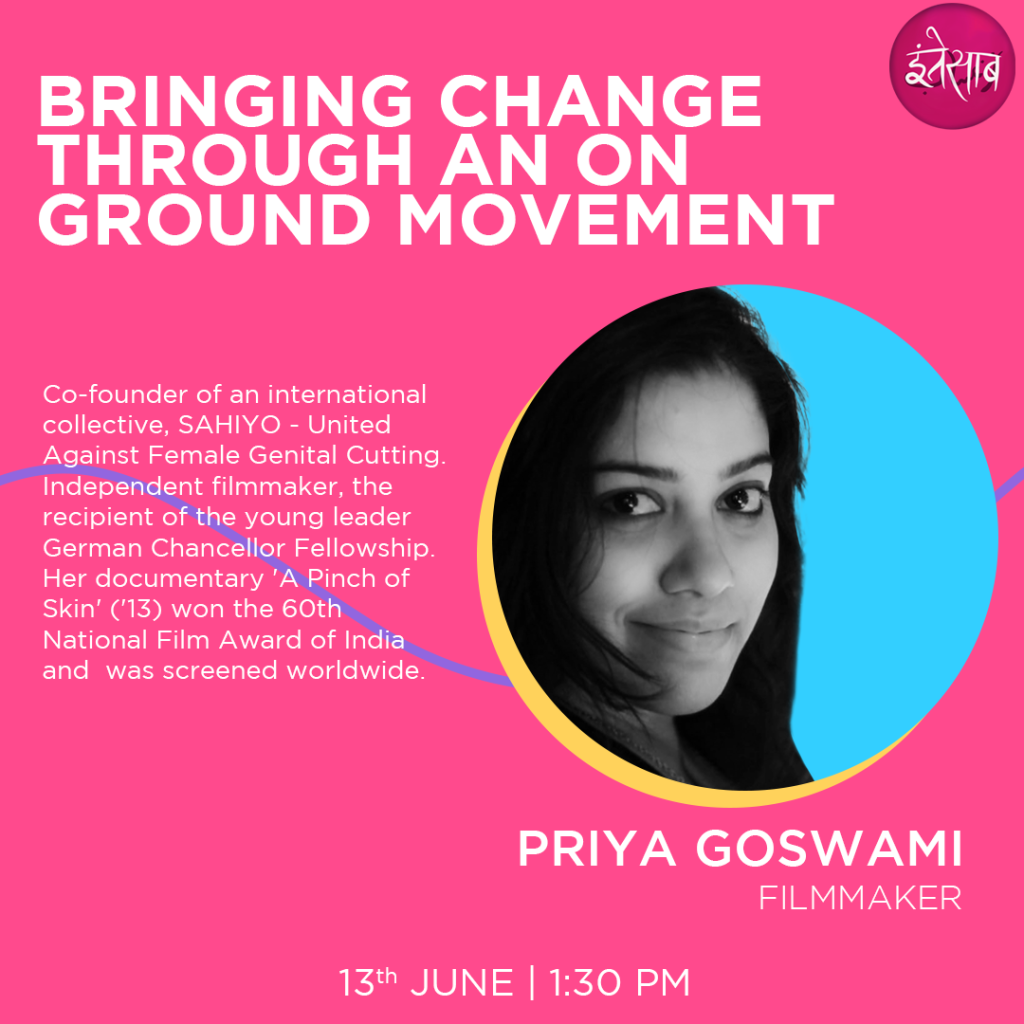
Sahiyo co-founder Priya Goswami gave a keynote speech at India’s first student-run online festival, Intesaab Fest 2020, supported by Ishaan Trust. Discussing change as an onground movement, she attributed Sahiyo’s growth to the sustained efforts of anti-FGC advocates and increasing community engagement. Her address titled, “Bringing Change through an on-ground movement,” also underscored the need for respectful communication and collaboration with the community. She spoke of fact checking not just the content, but also checking the visuals that accompany news reports, to avoid any sensationalist images and text. While also acknowledging the role and support of digital activists and media, she highlighted the importance of the stories keeping the interest of people who have undergone the practice at the forefront of all communication. The keynote address was met with resounding support for Sahiyo from the students who had joined the festival online.
Digital advocacy on female genital cutting in the time of COVID-19
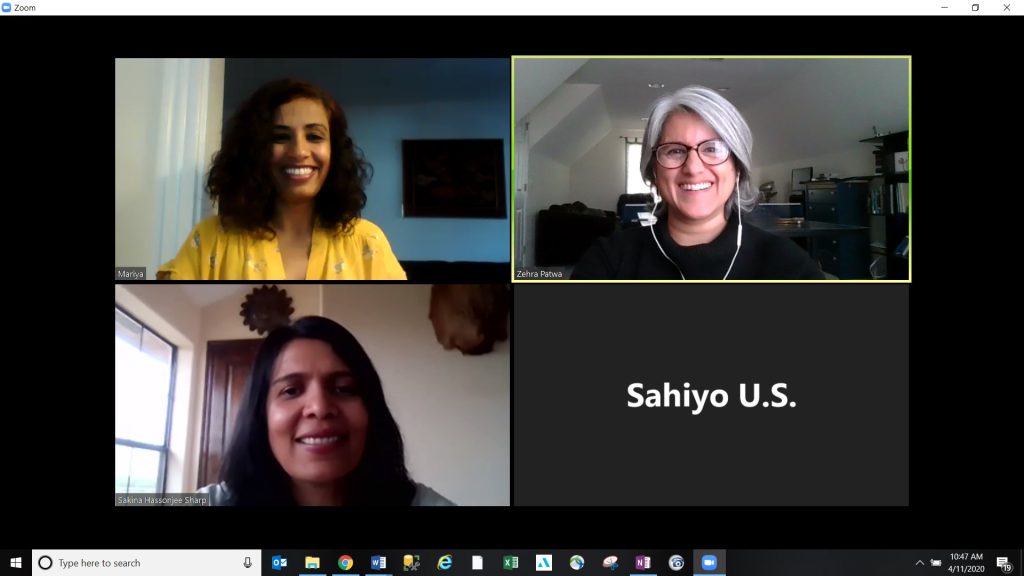
By Miranda Dobson “For many parents in the Bohra community who are thinking about having their daughters undergo female genital cutting, the delay that COVID-19 has caused is likely not a big deal, as it can happen any time from age 7. There is no time limit.” Aarefa Johari is a co-founder of transnational organisation Sahiyo, based in Mumbai, India. “For those who are unsure about whether or not to cut their daughters, this delay could mean there is more time to debate, and hopefully they may change their minds.” Sahiyo works with Asian communities, with a special focus within the Dawoodi Bohra community, which is largely concentrated in India and Pakistan, but also dispersed globally across Europe, North America and Oceania. Sahiyo focuses on ending female genital cutting (FGC), often known as female genital mutilation (FGM), and within the Bohra community as khatna by engaging in a variety of storytelling programs to help elevate dialogue on the issue and build awareness of its harms How is COVID 19 affecting the practice of female genital cutting? Fellow co-founder Mariya Taher, based in Boston, U.S., explained that the impact of the coronavirus pandemic on female genital cutting in the North American Bohra community and other FGC practising communities is likely similar. “It’s difficult to know if FGC is happening more or less right now. Broadly we know that gender-based violence is rising. Domestic violence is rising. The thing that is most immediately concerning is that necessary support services aren’t in place. “There is a poor response from law enforcement, and things like mental health services which were already lacking for survivors of FGC, are even more vital now and just not in place. This is likely the most difficult hurdle right now.” Mariya outlined how the pandemic is also affecting progress around ending FGC at a more structural level. “In Massachusetts where I am, the state law against FGC has been delayed because there are more pressing things to look at right now. Legislation is not a solution in itself but a necessary step towards change, and needs to be supported by community outreach.” Before the coronavirus pandemic hit, much of Sahiyo’s work involved working with activists and community members through in-person retreats and Thaal Pe Charchas – conversations over food. Sahiyo is adapting to the crisis In the current climate, Mariya, Aarefa and fellow co-founders, Priya Goswami and Insia Dariwala, have needed to pivot and work increasingly through technology and digital spaces. “A strength of Sahiyo’s is our digital presence,” Mariya added. “We’re able to still connect with community members in that way, and we held our first ever digital activist retreat in April, which was supposed to be in New York in person. “It was an experiment and we also had men attending for the first time, which was really cool. What surprised me was how engaged people were, and how much they wanted to talk about FGC, at a time when so much else is going on. I think it was very cathartic at a time when people just need an outlet more than anything.” Pivoting to digital advocacy Sahiyo has been able to work to their strengths as communicators at this time, and use digital spaces to convey messages, and to great success. They’ve held webinars with over 300 people in attendance, and continue to share survivor stories on their social channels through a project with StoryCenter called Voices to End FGM/C. Aarefa shared how Sahiyo India is likely to follow suit. “We had planned to have some community events at this time, which haven’t been possible. These could now happen virtually as a way to reach out to people. It’s encouraging how well this went in the U.S.” Sahiyo India has also recently launched the first iteration of an exciting new app. “It’s called Mumkin, and it’s about making difficult conversations possible. We’re excited to be rolling it out at a time when digital advocacy and communications are so important.” Aarefa and Mariya both recognised how COVID-19 is likely to affect communities and their work going forward on a range of levels. “It’s important to acknowledge that we’re living in this altered reality. We can’t just talk about FGC without talking about COVID – it’s not relatable and it doesn’t feel authentic because it’s the issue that everyone is facing,” Mariya told us. “In general, we’re seeing a shift in the social sector. COVID will be a focus for a lot of grants for a while. That’s really important and should be the case. I hope though that it doesn’t mean organisations will force-fit COVID into their work. Of course it’s vital, but it shouldn’t relegate other issues, particularly gender-based violence, which we know is being driven by barriers pandemic responses have put up.” (This interview was carried out via video conferencing and written by Orchid Project’s Senior Communications Manager, Miranda Dobson, speaking to Mariya Taher and Aarefa Johari, co-founders of Sahiyo. The piece was originally published on Orchid Project’s website.)
We are listening: Sahiyo’s statement on protests against police brutality
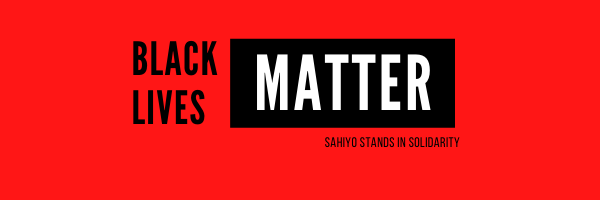
We at Sahiyo wanted to purposefully create space to address the continued protests against police brutality in the United States and globally, and explicitly state that we stand in solidarity with the protesters fighting for black lives. Many are coming forward to condemn the treatment of people of color. But we need to be clear in stating that it is black lives that we are focusing on right now. The U.S. has been built on and fueled by white supremacy and the active oppression of black people, enforced by the prison industrial system, the police and other agencies. As an organization working with South Asian communities, we recognize that colorism and anti-blackness exists within our communities, as well. We have benefited from the model minority stereotype, but we must make a choice now – we can choose to buy into the model minority trope, and align ourselves with whiteness. Or we can address the colorism and anti-blackness in our own community, and step forward as allies to stand beside this country’s black communities. The events of the past two weeks are happening at a time in which black Americans are getting consistently hit hardest by COVID-19, due to the structural inequality of the country, and the resulting high populations working in essential positions without access to proper healthcare, and a well-documented bias in the medical profession. These are incredibly disturbing times and it can be difficult figuring out the best ways to support and take action. Educate yourself, go to a protest, speak up when you hear anti-blackness around you. Speak up without centering yourself or performing allyship for social capital. Take care of yourself and the people around you. Of course, not everyone has the capacity to physically protest, especially during these already challenging pandemic times and the need to practice social-distancing to stay safe and healthy. There are a multitude of ways to still take action and show your support for racial equality and justice. Donate to campaigns and organizations working to create structural change: George Floyd Memorial Fund Black Visions Collective Reclaim the Block Campaign Zero National bail funds Watch in order to educate yourself on these issues: 13th Eyes On The Prize documentary series The Black Panthers: Vanguard of the Revolution Long Night’s Journey Into Day When They See Us Read and share information with friends and family: Articles: How To Be An Ally in Fighting Racial Injustice APF Honors Black History Month https://www.topospartnership.com/library/ The 1619 Project – The New York Times The Secret History of South Asian and African American Solidarity Books: The Fire Next Time by James Baldwin Biased by Jennifer Eberhardt How to be an Anti-Racist by Ibram X. Kendi Between The World and Me by Ta-Nehisi Coates The New Jim Crow by Michelle Alexander White Fragility by Robin DiAngelo Black Skin, White Masks by Frantz Fanon To Kill a Mockingbird by Harper Lee Long Walk to Freedom by Nelson Mandela Talking Back: Thinking Feminist, Thinking Black by bell hooks Ain’t I a Woman: Black Women and Feminism by bell hooks Listen: About Race Code Switch (NPR) Seeing White Intersectionality Matters (Hosted by Kimberle Crenshaw) These are only a handful of ways one can take action, but as a global community, we must do so, and we must ensure that all black lives matter. At Sahiyo, we are listening and we are here for the black community and all allies supporting change. With love, solidarity and hope, ~ The Sahiyo Team
How COVID-19 may increase gender-based violence, including FGM/C
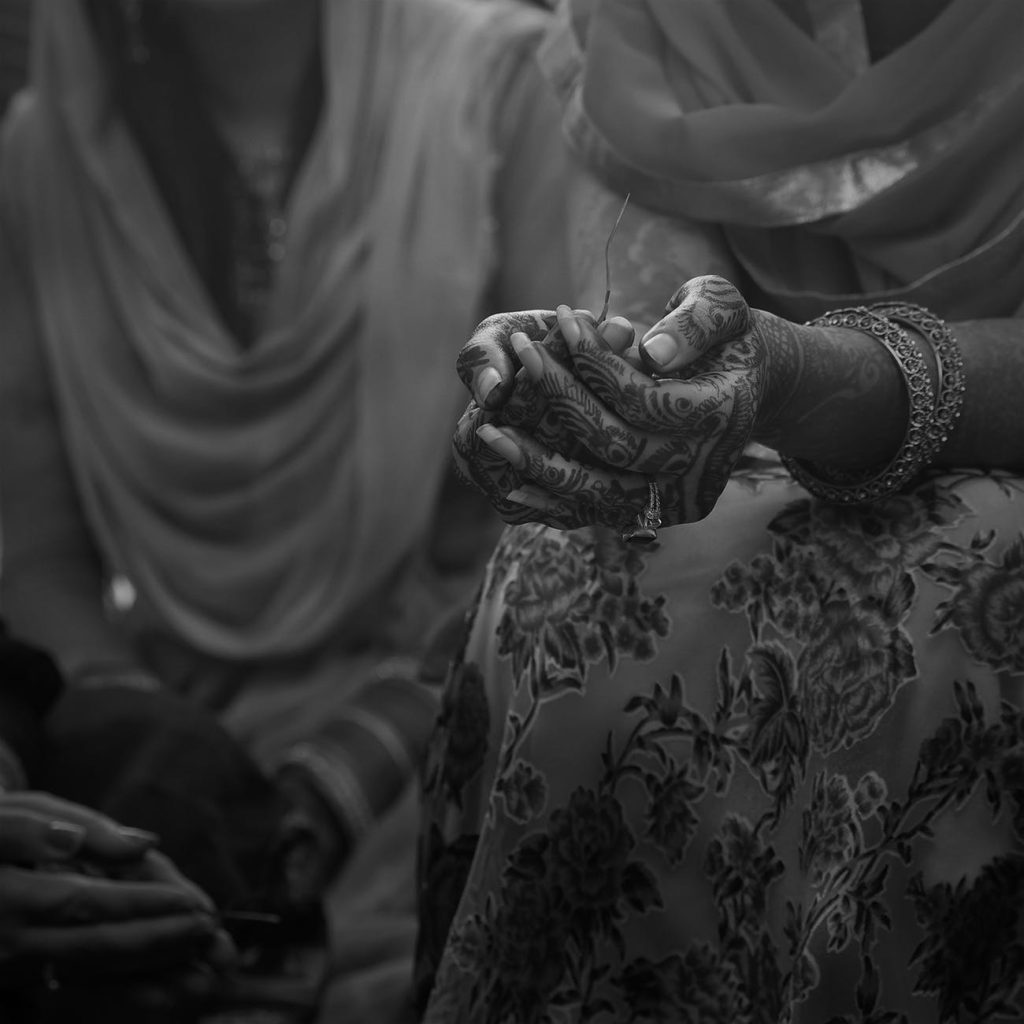
The UNFPA and UNICEF Joint Program on the Elimination of Female Genital Mutilation/Cutting (FGM/C) released a technical note about how the COVID-19 pandemic may affect women and girls adversely in regard to violence and inequalities. The COVID-19 pandemic has the potential to allow an additional two million cases of FGM/C due to restricted movement and confinement of people globally, disrupting the Sustainable Development Goal 5.3: Eliminating FGM/C by 2030. The closing of schools, restricted mobility and the inevitability of health care workers prioritizing COVID-19 patients heightens the need for supporting community-based women and youth groups identifying at-risk girls vulnerable to violence, including FGM/C. The brief is meant as a guide for UNFPA and UNICEF Joint Program staff and partners, other United Nations agencies, governments, civil society, and non-governmental organizations, on how to assess the impact COVID-19 may have on FGM/C programs. The call to action includes integrating FGM/C in COVID-19 preparedness and response plans; access to prevention, protection, and care services and community-based protection; alternative approaches to community-based interventions promoting the abandonment of FGM/C; opportunities presented by the pandemic; and adaptive monitoring and evaluation.
Voices to End FGM/C Launch: 27 survivors and activists create videos to share their stories

Important links: Watch the Voices to End FGM/C survivor and activist videos here, as they are released every week.Read blogs by participants of Voices to End FGM/C by following the “Voices Series” here. Today, the occasion of the International Day of Zero Tolerance towards Female Genital Mutilation/Cutting (FGM/C), Sahiyo and StoryCenter are proud to announce the release of ‘Voices to End FGM/C’, a series of 27 short videos addressing FGM/C, created by survivors and advocates from countries and communities around the world. ‘Voices to End FGM/C’ supports women and men impacted by this issue to tell their own stories, through their own perspectives, in their own words. Participants receive training on how to create videos at workshops held either in-person or via webinars. Says Global Voices Storyteller and FGM/C survivor Su Sun, “Participating in this storytelling process was for me to be audacious, heal, and denounce how women’s bodies are subjected to violence in many different ways. To share this process with other women was a beautiful process of collective empowerment that allowed us not to be invisible and do so while using our imagination, art, poetry, music, colours.” The program was first launched in May 2018 as ‘Sahiyo Stories’, when Sahiyo and StoryCenter hosted a residential workshop on digital storytelling for nine FGM/C survivors in Berkeley, California, in the United States. The videos created at that workshop, which have been screened at various events transnationally, can be viewed here. In 2019, Sahiyo Stories was expanded into the Voices to End FGM/C program, under which two residential workshops were conducted in the U.S. and one webinar-based workshop was conducted for 10 FGM/C survivors living around the world. Most participants in these workshops had not previously shared their personal experiences with FGM/C. They received primary training from StoryCenter, which helped them write their own scripts and curate their own photographs and videos clips to make the finished videos. Some participants also worked in partnership with illustrators/visual artists to aid in the storytelling. The 27 new digital stories emerging from Sahiyo and StoryCenter workshops will be released every Monday on Sahiyo’s Youtube page at http://bit.ly/VoicesFGMCVideos . Says Mariya Taher, Sahiyo Co-founder, US Network to End FGM/C Steering Committee Member, Voices to End FGM/C Program Director, and FGM/C Survivor, “I believe that to create change, we have to speak about the harms in our community — and storytelling allows us to do that in a safe and non-judgemental way. The online Voices to End FGM/C digital storytelling workshop has allowed survivors from around the world to connect to each other in a way that truly shows that FGC is a global issue requiring a global response.” Amy Hill, Silence Speaks Director, StoryCenter, explains Story Center’s motivation: “StoryCenter remains deeply committed to supporting women’s rights storytelling, through our Silence Speaks program. The partnership with Sahiyo on Voices to End FGM/C is rooted in the importance of creating safe environments where storytellers can forge new understandings of their own life experiences, repair fractured relationships with family members and other loved ones, and establish meaningful, new connections with their peers who are speaking out. Our hope is that collectively, these stories will influence conversations, community action, and policies in ways that ensure future generations of girls are spared.”
How Melinda Gates’ Moment of Lift addresses female genital cutting
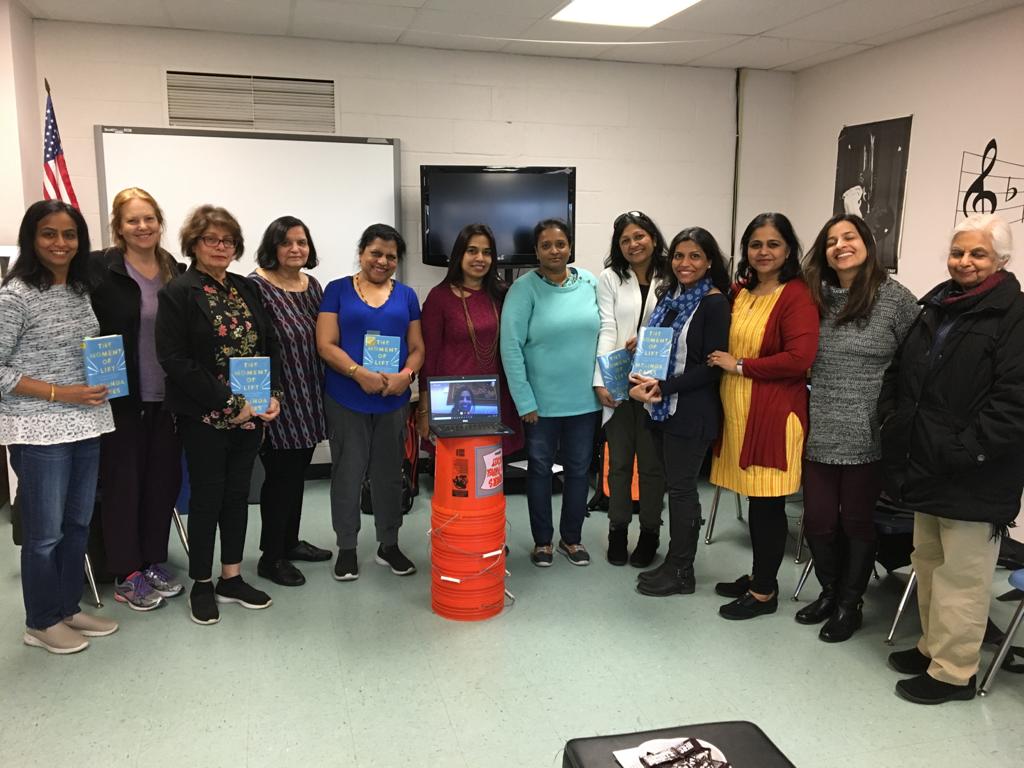
By Kristin Pepper In December 2019, our book club discussed Melinda Gates’ book, Moment of Lift, and experienced firsthand Melinda’s process ourselves. One of our members knew that the book mentioned female genital cutting (FGC), and asked Mariya Taher, an expert on FGC, to join our discussion using Skype. Just as Melinda looked into how to empower women and grew to understand women’s issues in a whole new way, our book club read a book about how women can help and learned many facets of a problem most of us barely knew existed. Mariya presented some facts to help us understand that FGC happens everywhere, including in the United States. We also had a member who knew that girls in our own town were being cut. Our book club is made up of mothers who live in an upper middle class, educated area in which all parents want the very best education for girls and boys alike. Most of our members had not realized girls, both Christian and Muslim living in the US, were being cut, much less in our own town. We were shocked and had an especially hard time understanding why a woman would be involved in cutting a girl. When discussing Moment of Lift, we kept coming back to why women perpetuate any customs that hurt other women. The story of girls tricked into child marriage made us angry at the mothers. Mariya showed us a video of a woman who used to hold down girls to be cut but later helped her community to reject FGC. Some of us had trouble forgiving that woman despite her courage and activism. We had followed Melinda Gates into discovering a problem happening in our area, as well as globally. We had to understand why FGC exists, how damaging it was to girls, and what we could do about it. Mariya helped us understand some of the social, medical and educational roots of the problem, as well as its true danger. She showed us videos of women describing the effect cutting had on their lives, but we also learned that not all women had problems from cutting. We learned the different methods of cutting. We tried to understand why educated women who clearly loved their children would have their girls cut. Mariya and the other book club member were invaluable in sharing their knowledge with us, just as the people who were closest to the problems were most valuable to Melinda. They helped us understand the loss a woman and her entire family faces if she speaks out against FGC in a community that accepts it. She and her family may no longer be valued members of the community. They may still go to their places of worship, but people may no longer talk to them, and they may no longer be invited to community gatherings. The ostracism and loss of support they have felt their whole lives is an extreme deterrent. This tied into Melinda’s journey of speaking out in support of birth control, despite being Catholic. She felt she had to publicly support family planning in order to have any impact on communities. It took courage to talk out against something her faith supported, and she was worried about wading into politically charged waters. We spoke about what the Gates Foundation did in one community to stop cutting, but to the members who understood FGC best, it was complicated. There might be a lesson in the MeToo movement. For years, women kept quiet about workplace sexual harassment, but then the MeToo movement supported speaking up and the society began to stop blaming the victims. It was very important that the women who spoke up were believed, welcomed and told they were brave. We need to support those who do speak up about FGC. Those brave women could break the notion that FGC does not hurt women’s health, and they could inspire their friends to speak out. Women who have been cut speaking up and denouncing the practice would have a powerful effect on their own communities, but they will need to be supported by people who understand what a loss they face when they raise their voices. Melinda Gates’ positive message that change is possible when women are given the right support to lift was a hopeful message that made a strong impression on our book club.
